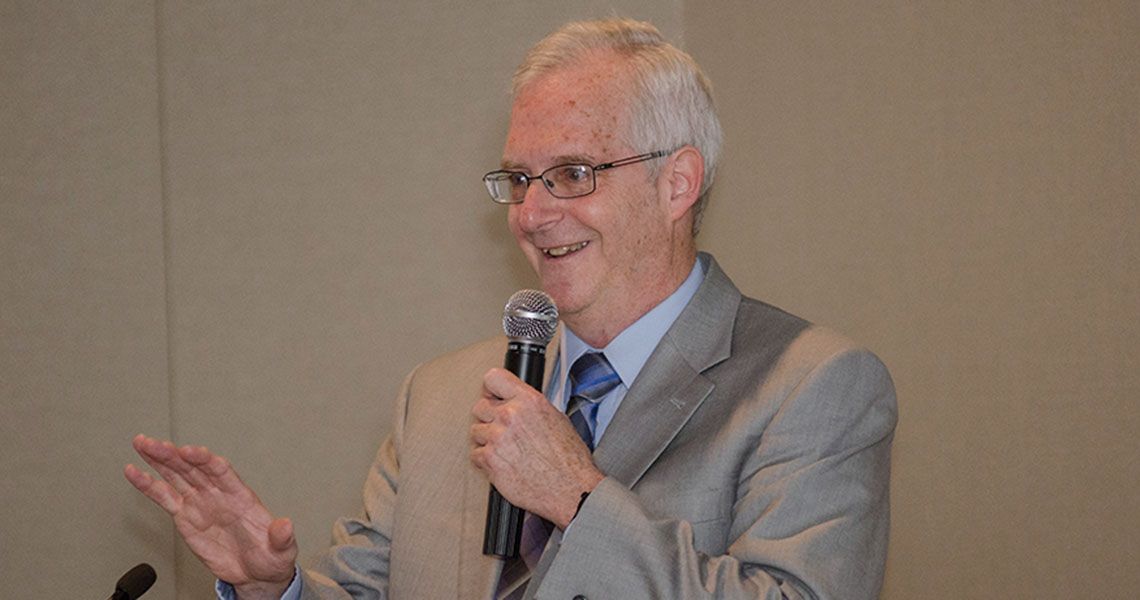Happiness, acknowledged Shawn Shea, MD, was an unusual choice for a lecture on suicidology. But, the founder and director of the Training Institute for Suicide Assessment and Clinical Interviewing added, what might be critical to preventing suicidal thoughts — and therefore suicide — is building happiness and resilience in people.
“I just think it’s OK for us to be happy. We should wake up in the morning and like what we’re doing, feel good about what we’re doing,” Shea said at the start of his talk, “Suicide Prevention in a New Light: Matrix Treatment Planning and the Quest for Happiness,” at the 23rd Annual Seymour Perlin, MD, Lecture on Suicidology.
Using both clinical and philosophical lenses, Shea drew on past figures — patients Anna and Timothy, as well as 14th century philosopher Julian of Norwich — to illustrate how psychiatrists can better create treatment plans to help patients avoid slipping into suicidal mindsets. Take Anna, for example. In 1979, “as hospice was just starting to rock and roll,” Shea said, the 80-year-old with ovarian cancer wasn’t expected to live long, yet her spirit, particularly to the young MD treating her, was remarkable.
“When I walked into [her] room, she started to smile and immediately said, ‘Dr. Shea, are you OK? You don’t look OK to me.’ [That is] the first puzzle piece to what happiness and resilience are about: a human being dying in pain, genuinely concerned about another,” Shea recalled.
The second puzzle piece, he added, involved Anna’s happy banter with her friends and family. “Here’s what I think was going on with her,” Shea explained. “Anna was comfortable with where she was in her life. She felt that she’d had a good life, she’d made good friends, had taken good care of her family, and I know that she believed in an anthropomorphic god. She was comfortable with the moment.”
Those two puzzle pieces that Anna provided, he added, led Shea to ask a fundamental question: Can a person be happy while suffering? “I would argue that Anna has already shown us it’s obviously possible,” he answered.
The third puzzle piece to happiness, one that incorporates the dichotomy of joy and pain, came from Julian, Shea said. The philosopher argued that balance is critical to happiness; in other words, to appreciate the light, or joy, one must experience the dark, or suffering. Former substance abusers who have long been sober, for example, are among the happiest people Shea’s met. “They know what it’s like to wake up in the morning and open their eyes and hate the world and hate themselves,” he explained. “They really value what it’s like to live now that they no longer feel that.”
Julian, Shea added, was also an anchoress, someone who had withdrawn from society to focus on her religious beliefs. Within her meager room, however, was a window, through which passersby would stop and tell her of their troubles. What she noticed was a similarity in tragedies, yet reactions to those tragedies could vary widely.
“What she came to realize is that the people who were suffering much, much more … [had] bitterness,” Shea said. “Not only does [the trauma] become markedly bigger, it goes on and on and on.”
The antidote to bitterness, he added, was hope. “If you truly do believe that no matter what comes your way you’re going to be able to reasonably cope with it, that is very hope-producing.”
So where do clinicians come in? By building on their own personal philosophies of happiness and resilience, clinicians “can help people to let go of the bitterness and the trauma of pain that is absolutely unnecessary,” Shea said. “I can give [patients] new skills that allow them to feel that they can cope better with what comes their way, give them some control over what’s coming their way, which indirectly opens the door to hope, which I would argue does prevent suicides.”
Shea’s patient, Timothy, for instance, suffered from severe schizo-affective disorder; he was a “weary, weary warrior,” Shea said, who felt that more than anything, he had disappointed his parents. So Shea, during a family meeting, pointed out Timothy’s ability to get up and start each day, knowing that he would be grappling with a severe mental illness. That, he said, was something to be proud of — and Timothy’s parents agreed.
“[His mother] looked at him like a laser: ‘Timothy, your father and I very proud of you,’ ” Shea recalled. “He burst into tears, she burst into tears, the father burst into tears, the case manager burst into tears, I burst into tears. Those were not tears of pain; those were tears of remarkable gratitude. … I think that is my favorite moment of healing.”
It’s that kind of support that helps prevent suicide and builds resilience, Shea argued. Human nature, he explained, allows people to lift themselves up using a variety of “wings”: spirituality, the environment, individual relationships, and psychologies, or ways of thought. When clinicians build on those wings, emphasizing happiness and resiliency, and subsequently design an appropriate treatment method — not unlike those prescribed in the biopsychosocial treatment model — suicide is avoidable.



